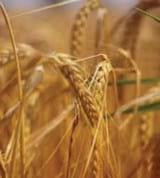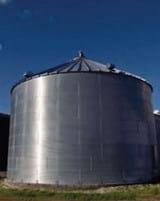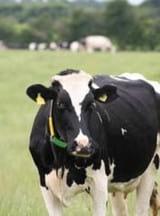Toxins in feed grain
Toxins – How do we prevent?
Published: April 15, 2011
By: Karsten T. Rasmussen (Vitfoss)
The occurrence of toxins can be classified into different groups. The most frequent occurring toxins are those produced in feed grain. These toxins can be divided into toxins formed before harvest and toxins formed after harvest. Toxins can also occur in different protein sources such as soy-, rapeseed- and sunflower products. FAO estimates that about 25% of the world's crops production contains toxins. There is a big variation between different countries due to clima, crophandling and cultivation strategies.

The toxins formed before harvest is frequently seen in periods with high humidity in the blossom-time of the grain. Problems around harvest time due to rainy weather when the grain is mature also increase the risk of formation of toxins. A very forced crop rotation, minimum tillage or an insufficient treatment strategy against fungicides in the growing period involves a higher risk of the occurrence of toxins. Fusarium fungi - typically formed before harvest - include many different fungi. As a group we call their toxins for fusariumtoxins. However, the analysis that is typically carried out is the analysis of DON, Vomitoxin and Zearalenone.
The toxins formed after harvest is caused by too late and insufficient drying of the grain. An inadequate cleaning of the crops increases the growth of the toxins. Toxin problems will in this case occur shortly after the new grain is being used. In grain that is stored in airtight silos the problems are often seen in the spring and in the early summer. At this time a large amount has been taken from the silo and thus the inlet of oxygen makes the toxins develop. These toxins will typically be ochratoxins.
Limit values for toxins have been made, but please note if a sample is collected from a batch, then it is only this particular quantity from the sample that is analysed. Meaning if the test result shows that the content of toxins lies just below the limit values - then you cannot be sure. Of course the results also can overestimate the problem, but we see that less often. Furthermore when you analyse for one or two toxins, there can be several others you are not analysing, and unfortunately different toxins can amplify the negative effect.

The symptoms of the occurrence of toxins in pigs can be classified into different groups.

In sows a weak or absent heat is often reported. Abortions are seen at increased occurrence of toxins, reduced litter sizes, hypertrophy of the mammary glands and possible diarrhoea in sows.

The toxins formed before harvest is frequently seen in periods with high humidity in the blossom-time of the grain. Problems around harvest time due to rainy weather when the grain is mature also increase the risk of formation of toxins. A very forced crop rotation, minimum tillage or an insufficient treatment strategy against fungicides in the growing period involves a higher risk of the occurrence of toxins. Fusarium fungi - typically formed before harvest - include many different fungi. As a group we call their toxins for fusariumtoxins. However, the analysis that is typically carried out is the analysis of DON, Vomitoxin and Zearalenone.
The toxins formed after harvest is caused by too late and insufficient drying of the grain. An inadequate cleaning of the crops increases the growth of the toxins. Toxin problems will in this case occur shortly after the new grain is being used. In grain that is stored in airtight silos the problems are often seen in the spring and in the early summer. At this time a large amount has been taken from the silo and thus the inlet of oxygen makes the toxins develop. These toxins will typically be ochratoxins.
Limit values for toxins have been made, but please note if a sample is collected from a batch, then it is only this particular quantity from the sample that is analysed. Meaning if the test result shows that the content of toxins lies just below the limit values - then you cannot be sure. Of course the results also can overestimate the problem, but we see that less often. Furthermore when you analyse for one or two toxins, there can be several others you are not analysing, and unfortunately different toxins can amplify the negative effect.

The symptoms of the occurrence of toxins in pigs can be classified into different groups.

In sows a weak or absent heat is often reported. Abortions are seen at increased occurrence of toxins, reduced litter sizes, hypertrophy of the mammary glands and possible diarrhoea in sows.
In piglets reduced appetite, swelling and reddening of the vulva, vomiting and infections in the mucous membrane are often seen. Reduced appetite, reduced daily gain, aggressive behaviour and vomiting are also seen in finishers.
In cattle herds the first symptoms are typically reduced milk production.
If suddenly there is a change into a more diarrhoea-like faeces consider if there has been a change to another raw material in the feed ration. Especially maize silage can be a risk factor of fusarium toxins.

There are very good analytic methods to control grain quality for content of toxins and guiding limit values are determined.
Analysis of Vomitoxin, Zearalenone and Ochratoxin should be made at any suspicion of toxins. Toxin binders should be added to the feed if one of these toxins is found at or above limit values. Toxin binders available on the market today have a quite good effect, but the advice is to do as much as
possible to avoid the occurrence of toxins. The use of toxin binders does not remove the toxins - they are absorbed and transported through the digestive system of the animals.
The toxin binder should be chosen according to the found toxin. Some toxin binders are effective to Vomitoxins and others to Zearalenone etc. That is why analyses are so important - you can focus very determined on the toxins found in the analyses.
Toxin binders can be added in the mineral mixes for both pig- and cattle production to ensure a constant and correct dosage of toxin binders.
In cattle herds the first symptoms are typically reduced milk production.
If suddenly there is a change into a more diarrhoea-like faeces consider if there has been a change to another raw material in the feed ration. Especially maize silage can be a risk factor of fusarium toxins.

There are very good analytic methods to control grain quality for content of toxins and guiding limit values are determined.
Analysis of Vomitoxin, Zearalenone and Ochratoxin should be made at any suspicion of toxins. Toxin binders should be added to the feed if one of these toxins is found at or above limit values. Toxin binders available on the market today have a quite good effect, but the advice is to do as much as
possible to avoid the occurrence of toxins. The use of toxin binders does not remove the toxins - they are absorbed and transported through the digestive system of the animals.
The toxin binder should be chosen according to the found toxin. Some toxin binders are effective to Vomitoxins and others to Zearalenone etc. That is why analyses are so important - you can focus very determined on the toxins found in the analyses.
Toxin binders can be added in the mineral mixes for both pig- and cattle production to ensure a constant and correct dosage of toxin binders.
Related topics:
Authors:
Vilofoss
Recommend
Comment
Share
Recommend
Reply

Would you like to discuss another topic? Create a new post to engage with experts in the community.







.jpg&w=3840&q=75)